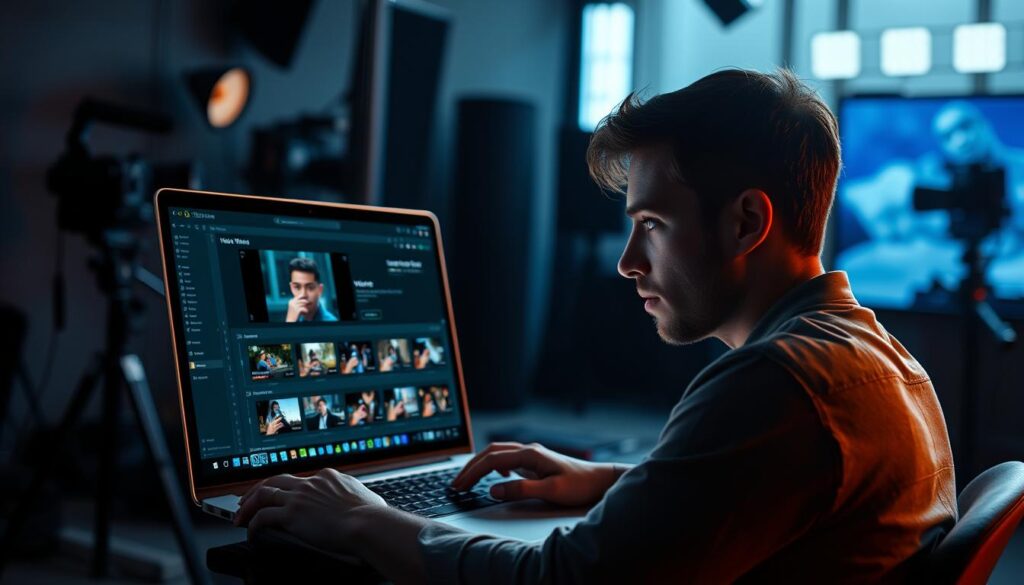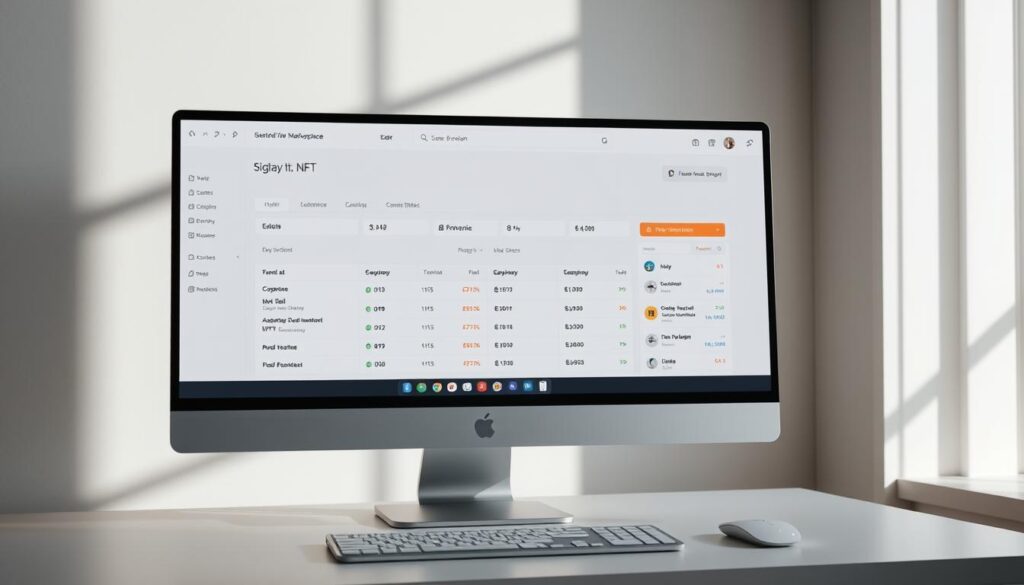Now Reading: Effective NFT Video Content Creator Monetization Techniques
- 01
Effective NFT Video Content Creator Monetization Techniques
Effective NFT Video Content Creator Monetization Techniques

The digital landscape has undergone a remarkable transformation with the emergence of unique digital assets. These blockchain-based tokens represent a fundamental shift in how artists and producers can generate income from their work.
Unlike traditional cryptocurrencies that are interchangeable, each token is completely unique and cannot be replicated. This uniqueness provides verifiable ownership and opens up entirely new revenue streams beyond conventional advertising models.
The market for these digital collectibles has experienced explosive growth. The music sector alone is projected to reach $80 billion by 2025, while gaming markets are expected to hit $942.58 billion by 2029. These figures demonstrate the substantial commercial potential available.
Real-world success stories highlight the earning possibilities. The famous “Charlie Bit My Finger” clip sold for $760,999, showing what’s achievable. Major platforms have recognised this technology’s potential to strengthen relationships between artists and their audiences.
This introductory section establishes why these digital assets matter specifically for film-makers and producers. It sets the stage for exploring practical implementation strategies throughout our guide.
Key Takeaways
- Unique digital assets on blockchain technology offer new income opportunities
- Each token is completely distinct and cannot be duplicated or divided
- The market shows tremendous growth potential across multiple sectors
- High-value sales demonstrate significant revenue possibilities
- Major platforms recognise the relationship-building potential
- Traditional advertising models are being supplemented by innovative approaches
- Verifiable ownership creates new value propositions for digital works
Overview of NFT Video Content Creator Monetisation Foundations
Before the advent of blockchain solutions, digital creators struggled with widespread copying and limited earning potential. The internet made distribution easy but protection difficult.
The evolution of digital art and video monetisation
Early digital artists faced significant challenges. Their work could be duplicated infinitely without proper attribution or compensation. This created a system where exposure didn’t always translate to earnings.
The traditional model relied heavily on advertising revenue and platform-specific programmes. These approaches often left makers with limited control over their intellectual property and revenue streams.
Understanding blockchain technology and its significance
Blockchain technology introduced a revolutionary solution. This decentralised ledger creates immutable records that verify authenticity and track ownership history. Each transaction is permanently recorded across multiple computers.
The Ethereum blockchain became the primary platform for this innovation. It supports smart contracts—self-executing programmes that automate royalty payments and define ownership terms. Alternatives like Flow and Tezos offer different features for digital assets development.
This technological foundation enables creators to establish verifiable ownership. It represents a fundamental shift in how artistic works can be valued and traded in the digital space.
NFT Fundamentals for Video Content Creators
Understanding the core principles of this technology is the first step towards leveraging its potential. This section breaks down the essential concepts you need to know.
What are NFTs and why they matter
The concept of ‘non-fungible’ is central to understanding the unique value proposition of these blockchain-based assets. Unlike a pound or a bitcoin, which are fungible and interchangeable, each token is one-of-a-kind.
This uniqueness is proven by a digital signature recorded on a public ledger. For filmmakers, this transforms a digital file into a verifiably rare collectible.

Exploring digital ownership and uniqueness
This technology solves a long-standing digital problem: proving who owns an original work. The blockchain acts as an unchangeable record of authenticity and transaction history.
It is crucial to note that buying a token typically grants ownership of that specific asset, not the underlying copyright to the work itself, unless specified. This distinction is key for artists.
The table below clarifies the fundamental differences between fungible and non-fungible assets:
| Feature | Fungible Asset (e.g., Bitcoin) | Non-Fungible Asset (e.g., NFT) |
|---|---|---|
| Interchangeability | Each unit is identical and interchangeable. | Each unit is unique and cannot be directly exchanged. |
| Divisibility | Can be divided into smaller units (e.g., satoshis). | Typically exists as a whole, indivisible item. |
| Value Basis | Value is based on market supply and demand for identical units. | Value is based on the unique properties and scarcity of the individual asset. |
| Primary Function | Acts as a currency or medium of exchange. | Represents ownership of a unique item, digital or physical. |
This framework empowers makers by creating digital scarcity. It opens a new way to earn from their art, moving beyond traditional models.
NFT Video Content Creator Monetisation Strategy
Building a successful monetisation strategy requires establishing a solid technical foundation. This involves setting up essential tools and understanding the automated systems that manage ongoing earnings.

The first critical step is selecting a secure digital wallet. This software stores the digital assets and the cryptocurrency needed to pay for blockchain transactions, often called gas fees.
Wallets come in two primary forms, each with distinct security implications.
Setting up your digital wallet and marketplace profiles
Hot wallets are connected to the internet, offering convenience for frequent trading. Cold wallets are physical, offline devices, providing superior security for long-term storage.
After securing a wallet, the next move is to create a professional profile on a chosen platform. A well-presented profile on a leading marketplace builds credibility and attracts serious collectors.
Implementing smart contracts for royalty management
The true power for creators lies in smart contracts. These self-executing programmes are the core technology behind automated royalty payments.
They are programmed with rules that define resale terms. Every time one of your NFTs is sold on the secondary market, the contract automatically sends a percentage of the sale price directly to your wallet.
The table below outlines the key differences between wallet types to guide your selection:
| Feature | Hot Wallet (Online) | Cold Wallet (Offline) |
|---|---|---|
| Connection | Permanently connected to the internet | Stored offline, only connected for transactions |
| Security Level | Convenient but more vulnerable to online threats | Highly secure, immune to remote hacking |
| Ideal Use Case | Frequent trading and active minting | Long-term storage of high-value assets |
| Example | Browser extensions like MetaMask | Hardware devices like Ledger or Trezor |
This infrastructure eliminates manual royalty collection. It creates a reliable, passive income stream from your work.
Creating and Minting Your NFT Videos
Preparing your visual creations for the blockchain marketplace demands attention to both artistic and technical details. The minting process transforms your digital artwork into a unique token that collectors can own and trade.

Step-by-step process for minting your video content
The journey begins with selecting your best work. Choose footage that represents your unique artistic vision. Ensure you have full rights to all elements in your production.
Next, upload your file to a chosen platform. Add descriptive metadata including titles and tags. These details help potential buyers discover your art through search functions.
Set your pricing strategy and royalty terms. The final step involves paying activation fees, which can vary based on network congestion.
Best practices for optimising video quality and authenticity
High-resolution formats like MP4 or MOV work best for blockchain platforms. Maintain original quality while considering file size limitations. Compress files appropriately without sacrificing visual appeal.
Document your creation process to establish provenance. This builds collector confidence in your artwork’s authenticity. Clear documentation creates a compelling story for your digital assets.
The table below outlines key considerations for preparing your visual work:
| Preparation Aspect | Technical Requirements | Creative Considerations |
|---|---|---|
| File Format | MP4, MOV, or WebM supported by most platforms | Choose format that preserves artistic integrity |
| Resolution | Minimum 1080p, ideally 4K for premium value | Higher resolution enhances collector experience |
| File Size | Balance quality with blockchain storage limits | Optimise without compromising visual impact |
| Metadata | Descriptive titles, tags, and creation details | Tell your artistic story through descriptions |
Following these guidelines ensures your minted tokens represent your work in the best possible way. Proper preparation leads to successful launches and lasting value for collectors.
Choosing the Right NFT Marketplaces and Platforms
The marketplace ecosystem offers diverse environments, each catering to specific artistic styles and collector demographics. Selecting the optimal platform significantly influences how collectors perceive and value your digital artwork.

Comparing key platforms like OpenSea, Rarible and Foundation
OpenSea dominates as one of the largest nft marketplaces, supporting diverse digital collectibles. Its flexible pricing options suit both emerging and established artists. The platform’s extensive user base provides excellent exposure opportunities.
Foundation operates as an exclusive, invite-only marketplace focusing on high-quality art. This model creates perceived scarcity, ideal for artists seeking premium positioning. The platform’s curation adds prestige to accepted works.
Rarible distinguishes itself through community governance where token holders influence platform development. This user-friendly approach empowers both creators and collectors. The platform’s democratic structure fosters strong community engagement.
SuperRare specialises in unique, limited-edition digital art targeting high-end collectors. Meanwhile, Mintable offers beginner-friendly features including gasless minting options. This reduces financial barriers for new artists exploring these services.
Each platform attracts distinct collector demographics and enforces different quality standards. Understanding these differences helps artists select marketplaces aligning with their artistic vision and commercial goals. Multi-platform strategies can maximise exposure across different audience segments.
Leveraging Auctions, Fixed Prices and Open Editions
The strategic deployment of different sales methodologies can significantly impact both immediate revenue and long-term community growth. Choosing the right approach depends on your artistic goals and target audience.
Strategies for auction-based releases
Auction formats create excitement through competitive bidding. They work best for unique or highly anticipated works. Setting an appropriate reserve price protects your minimum value expectations.
Timing is crucial for auction success. Shorter durations create urgency, while longer periods allow broader exposure. Consider your audience’s availability when scheduling these events.
Benefits of fixed-price sales and open editions
Fixed-price listings offer straightforward purchasing. Collectors appreciate the certainty of immediate acquisition. This approach works well for establishing clear value propositions.
Open editions allow multiple copies during a limited time window. They democratise access while maintaining scarcity through temporal limits. This method can generate substantial revenue through volume.
The table below compares key characteristics of each release method:
| Method | Best For | Revenue Potential | Community Impact |
|---|---|---|---|
| Auction | Unique, high-value works | Potentially exceeds expectations | Creates excitement and competition |
| Fixed Price | Establishing clear value | Predictable, immediate returns | Accessible to all collectors |
| Open Edition | Building large collector bases | Volume-based earnings | Expands community reach significantly |
Each approach offers distinct advantages. Many artists combine methods for optimal results. The right choice depends on your specific goals and audience characteristics.
Ensuring Authenticity and Securing Intellectual Property
The relationship between token ownership and intellectual property rights requires careful consideration. Blockchain technology provides powerful tools for protecting your digital work.
When you create a token, you generate a permanent digital certificate stored across a decentralised network. This ledger tracks all transactions, creating an unchangeable history. This record establishes your identity as the original maker and the exact creation timestamp.
Blockchain records as proof of originality
These immutable records serve as legal evidence of your work’s authenticity. If someone attempts to sell unauthorised copies, the blockchain proves your original claim. This system makes identifying infringement significantly easier.
It’s crucial to understand that selling a token typically transfers ownership of that specific digital item only. Unless explicitly stated, you retain all underlying copyright and intellectual property rights. This distinction protects your creative control.
Smart contracts can encode specific usage permissions for buyers. You can define whether purchasers receive personal display rights or commercial usage privileges. This flexibility allows you to generate revenue while maintaining control over how your work is used.
| Aspect | Token Ownership | Copyright Ownership |
|---|---|---|
| What is Transferred | Ownership of the specific digital token | Rights to reproduce, distribute, or adapt the work |
| Default Status | Transferred to buyer upon sale | Retained by original artist unless specified |
| Legal Protection | Established by blockchain record | Protected by copyright law |
| Monitoring Needs | Tracking secondary market sales | Watching for unauthorized reproductions |
Maintain thorough documentation of your creation process, including original files and timestamps. This supports your authenticity claims if disputes arise. Regular monitoring of secondary markets helps detect potential violations.
Advanced Techniques for Sustained Revenue
Building lasting financial success requires moving beyond the initial sale. This involves setting up systems that generate income over time and deepen connections with your audience.
Smart contracts are the engine behind this long-term approach. They automate payments without any manual effort from artists.
Setting up recurring royalties and passive income streams
One of the most powerful features is programmable royalties. When you create a digital asset, you embed a percentage that pays you on every future resale.
For instance, a 10% royalty on a piece that resells for $1,000 automatically sends $100 to your wallet. This creates a reliable stream of money as your work gains value.
The table below shows how royalties accumulate across multiple sales, illustrating the power of passive earnings.
| Sale Number | Sale Price | Royalty Percentage | Your Earnings |
|---|---|---|---|
| Initial Sale | $500 | N/A | $500 |
| First Resale | $1,500 | 10% | $150 |
| Second Resale | $3,000 | 10% | $300 |
| Total Earnings | $950 |
This system ensures you benefit from the success of your creations long after the first transaction. It’s a fundamental shift in how creators can earn.
Integrating exclusive content to engage your community
Digital tokens can act as keys to special experiences. Owners might gain access to private footage, early releases, or interactive events.
This approach builds a strong community of dedicated fans who feel a closer connection to your work. Musicians, for example, have successfully used these methods to offer unique albums and concert perks.
These strategies for earning money mirror membership models, rewarding supporters with tiered benefits. It turns collectors into an active, engaged audience.
Exploring NFT Trends in Content and Music Videos
Musical artists are pioneering new frontiers by transforming how fans experience their work through blockchain tokens. The music sector’s embrace of this technology demonstrates its potential for direct artist-fan connections.
Case studies and emerging successful projects
Kings of Leon made history by releasing their album as digital collectibles. This innovative project offered exclusive perks to token holders. Tom Bilyeu’s tiered approach provided varying benefit levels to supporters.
The music token market shows explosive growth potential. Projections indicate it could reach $80 billion by 2025. Gaming integration follows similar expansion patterns with nearly $1 trillion forecasts.
Hybrid models combine digital ownership with physical items. Robert Mondavi Winery’s collaboration included porcelain bottles with authenticity tokens. This approach adds tangible value to digital acquisitions.
Major brands like Marriott and Pringles experiment with token-based marketing. Their projects demonstrate corporate interest in this space. These collaborations offer new engagement methods for content creators.
Cross-industry applications reveal transferable strategies. Artists can adapt successful approaches from gaming and corporate sectors. This innovation continues evolving with AI-generated collections entering the space.
Addressing Challenges and Overcoming Market Risks
Successfully navigating the world of digital collectibles involves recognising and preparing for potential obstacles. While the technology offers exciting opportunities, understanding the risks helps artists build sustainable careers.
Market fluctuations present one significant challenge. The value of these assets often correlates with cryptocurrency prices, which can change dramatically.
Managing cryptocurrency volatility and digital piracy
Price swings can affect both initial sales and ongoing royalty income. Many digital artworks sell for under $200, despite occasional million-dollar headlines.
This volatility requires psychological resilience and long-term perspective. Diversifying across different platforms and timeframes helps manage this risk.
Digital piracy remains another concern. Anyone can download digital files, but ownership represents something different entirely.
YouTube’s exploration of this technology acknowledges its potential to give fans verifiable ownership of exclusive material. This distinction between access and ownership is crucial for artists to communicate.
Effective audience engagement strategies
Building a strong community helps mitigate market risks. Engaged supporters value ownership beyond simple file access.
Effective strategies include offering exclusive content to token holders. This creates additional value that cannot be pirated or replicated.
Diversifying across multiple platforms reduces dependency on any single marketplace. Emerging decentralised storage solutions may also help artists bypass traditional platform limitations.
These approaches help creators build sustainable models that withstand market fluctuations and protect their work’s value.
Conclusion
Looking ahead, the integration of this technology promises to reshape the creative economy fundamentally. It empowers artists with true ownership of their digital work, moving beyond traditional models.
The ability to earn automated royalties from secondary sales represents a paradigm shift. This creates sustainable income and deepens connections with audiences.
While market fluctuations exist, the potential for direct engagement is immense. Major platforms recognise this, signalling long-term viability. The best way forward involves education and starting small.
Begin by understanding the minting process. This technology is a powerful tool for any creator building their future in the digital world.
FAQ
How do I start selling my artwork as digital assets?
To begin, you’ll need a cryptocurrency wallet to store your funds and digital items. Then, choose a platform like OpenSea or Rarible to create a profile. The final step involves minting your work, which turns your creation into a unique token on the blockchain.
What are the benefits of using smart contracts?
Smart contracts automate transactions and ensure you receive royalties automatically every time your art is resold. This technology provides a transparent and secure way to manage ongoing earnings from your initial sale without manual intervention.
How can I protect my intellectual property rights?
The blockchain serves as an immutable public record, providing clear proof of your ownership and the artwork’s creation date. This ledger helps secure your rights and establishes authenticity, making it difficult for others to claim your work as their own.
Which marketplace is best for releasing music videos?
Platforms differ in their audience and specialisations. Foundation often attracts art collectors, while Rarible supports a wide range of media. Research each platform’s community and fee structure to find the best fit for your project and target audience.
What is the difference between an auction and a fixed-price sale?
Auctions allow buyers to bid, potentially increasing the final sale price through competition. Fixed-price sales offer immediate purchase at a set cost, providing certainty. Open editions enable multiple sales of the same piece for a limited time, broadening access.
How does royalty management provide sustained revenue?
By programming royalties into your asset’s smart contract, you earn a percentage of all future sales on secondary markets. This creates a passive income stream, rewarding your ongoing contribution to the artwork’s value long after the first transaction.
What are the risks involved in this type of monetisation?
The value of cryptocurrency can be volatile, affecting your earnings. There is also a risk of digital piracy, though blockchain records help combat this. Building a strong, engaged community is key to mitigating these challenges and ensuring lasting success.












